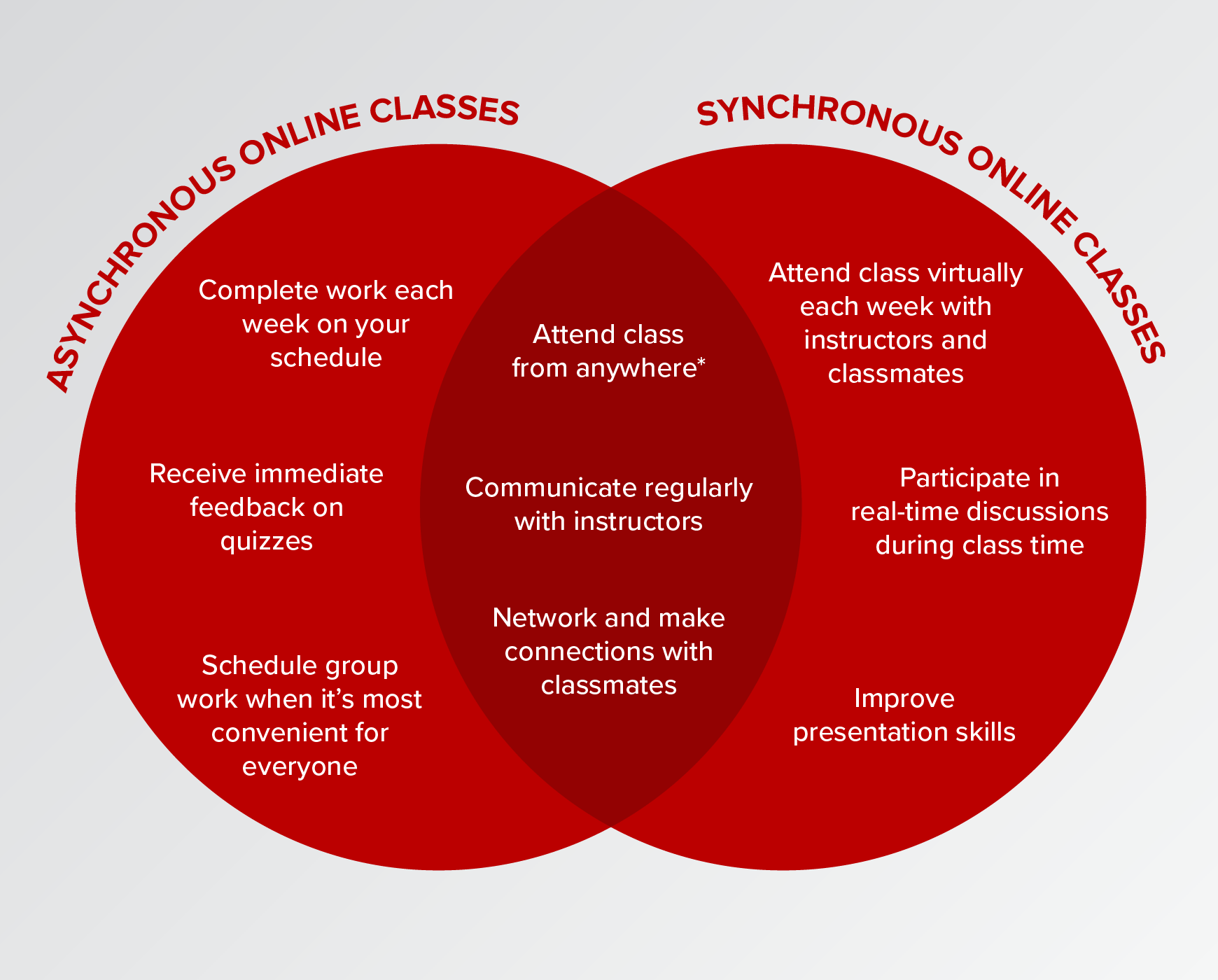What's the Difference Between Asynchronous and Synchronous Learning?
As you learn more about taking online classes, you may come across the terms “asynchronous” and “synchronous." You might not know what these words mean yet, but you’re probably already considering your other responsibilities and how these classes will fit into your life. Are you able to log on and attend classes at specific times? Or is it more realistic for you to complete work each week at times that suit you best – no matter if it’s 3 p.m. or 3 a.m.?
We tapped Ohio State experts to explain the difference between asynchronous and synchronous learning and what each style actually means when it comes to online classes.

What is asynchronous learning?
Asynchronous learning allows you to learn on your own schedule, within a certain timeframe. You can access and complete lectures, readings, homework and other learning materials at any time during a one- or two-week period.
“A big benefit to asynchronous classes is, of course, the flexibility. Asynchronous classes mean that you don’t always need to be online at the same time as your instructor or classmates,” said Instructional Designer John Muir, who works with faculty to develop classes for Ohio State's online programs.
Online asynchronous classes might include short videos teaching key concepts that you can watch over and over again, if necessary. In some classes, students can also complete homework assignments and receive immediate feedback, as opposed to waiting for instructors to grade them.
But don't get the idea that asynchronous classes are any less rigorous than their synchronous or on-campus counterparts.
“Just like a student on campus, you should expect to be doing work one week at a time,” Muir said. “You should also expect to have contact with your instructor and classmates every week in a substantial way.”
For example, in HTHRHSC 4300: Contemporary Topics in Health and Society, a capstone course in the BS in Health Sciences program, students do most of their work according to their own schedules. However, they also sort themselves into groups based on schedule and availability, meeting weekly via video conferencing to collaborate on a research project that spans the semester.
What is synchronous learning?
Synchronous learning means that although you will be learning from a distance, you will virtually attend a class session each week, at the same time as your instructor and classmates. The class is a firm, weekly time commitment that cannot be rescheduled. Much like an on-campus class, you will have readings and assignments to complete outside of class time to help prepare you to participate in the discussion. This kind of preparation from students, along with a dedicated agenda set by the instructor, ensures each class session is productive.
“A lot of careful planning and set up ahead of time makes those sessions into meaningful connections," Muir said. “If the students can do it, and it’s thought through well by instructors, it can be a really powerful thing to add.”
Online synchronous learning doesn’t always just take the form of a live video lecture or an instructor-led discussion. Often, students will lead discussions themselves or give presentations to the rest of the class. In an online class, group work doesn’t go away, it just looks a little different. Muir explains that some instructors will pose case studies to students, who then have to negotiate an answer first as a small group and then together, as a class. Specific types of activities included in a synchronous course depend on the course and the program.
“There’s a lot of discipline-specific, really active things that go on in those sessions that aren’t just the equivalent of a recorded lecture,” Muir said. “It really is the same as doing some sort of activity in the classroom, just in a virtual setting.”
For example, NURSPRCT 8600: Organizational Culture in Ohio State's Doctor of Nursing Practice program, requires that students attend weekly evening class sessions using CarmenZoom. Class discussion and interaction with the instructor occurs mainly during these meetings, with homework and readings available at any time in CarmenCanvas, Ohio State's online learning management system.
 Different schedules, but the same commitment
Different schedules, but the same commitment
No matter if your class is mostly asynchronous or synchronous, Muir reminds students to be deliberate with their time in order to be successful.
“You really have to be respectful of yourself and plan your time and efforts,” he said. “It doesn’t matter if you’re in a synchronous or an asynchronous class, you need to know to block off your time to accomplish those things.”
Vivian Jones, M.Ed., academic advisor, says she often works with students who aren’t sure how synchronous or asynchronous classes will fit into their lives. To start with, knowing yourself and your own limitations is key to making decisions regarding your education.
“Remember that an online degree program itself is time-consuming,” Jones said. “Consider how you will manage a work-school-life balance. There is a lot of self-discipline involved.”
Jones said she also hears from students who fear they’ll feel disconnected or disengaged in an asynchronous, online course.
To combat feelings of isolation, Jones recommends students always reach out to their instructors and classmates and attempt to make meaningful connections.
“Respond to discussion posts and find people with similar interests to you or people doing things you don’t even know about, so you can maybe learn more about them,” she said. “Make relationships just as you would in a physical classroom.”
In an online class, student engagement needs to be more purposeful than an in-person class, where engagement may take place more naturally, but it’s crucial to ensure all students feel invested in their coursework.
“With online learning, student engagement is just different,” Jones said. “I see instructors in online classes really making an effort to make things personable and make people feel included. We’re trying to bring everyone together as one community, because online students are part of the Ohio State community.”

